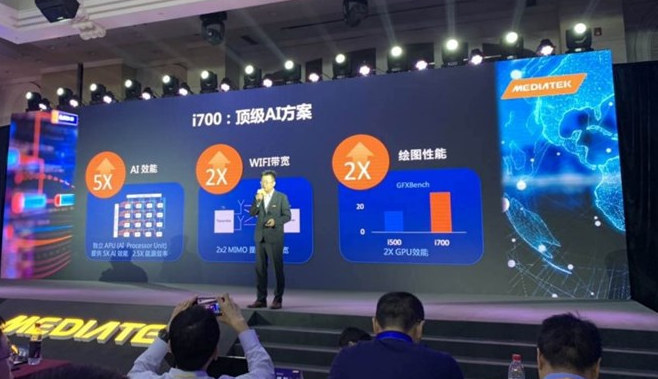MediaTek has recently unveiled their i700 octa-core AI IoT Platform, which succeeds their little known MediaTek i500 (MT8385) processor, and features two Cortex-A75 cores, six Cortex-A55 cores, coupled with MediaTek APU 2.0 comprised of a dual-core AI processor, AI Accelerator and AI face detection engine that is said to offers 5x greater performance than the i500..
The new SoC also features an Imagination 9XM GPU clocked at 970MHz, as well as a tri-core ISP with support for a single 32MP camera or a 24MP+16MP dual-camera setup.

MediaTek i700 key features & specifications:
- CPU – 6x Arm Cortex-A55 cores @ 2.0 GHz, 2x Arm Cortex-A75 cores @ 2.2 GHz
- GPU – Imagination PowerVR 9XM-HP8 (GM9446?) GPU @ 970 MHz
- MediaTek APU 2.0 AI engine – Dual-core AI processor, AI Accelerator, AI Face Detection Engine; Neuropilot SDK support
- Memory – Up to 8GB LPDDR4x, 1866MHz
- Connectivity
- Cellular – Carrier Aggregation (CA), CDMA2000 1x/EVDO Rev. A (SRLTE), FDD/TDD LTE Cat.12, HSPA+
- Bluetooth 5.0
- Dual band 802.11a/b/g/n/ac Wi-Fi 5 2×2 MIMO
- Camera – Support for single 32MP camera or a 24MP+16MP dual-camera setup. 14-bit RAW and 10-bit YUV processing
The new processor is with Google’s Android Neural Networks API (NNAPI), as well as frameworks including TensorFlow, TensorFlow Lite, Caffe and Caffe2.
Typical applications for MediaTek i700 include automated stores and facial recognition payments, as well as facial biometrics access control, employee time clocks, and the obstacle detection systems in automated forklifts. There’s also a 3D human pose detection functionality that could be useful to fitness coaching services, or for safety when a user performs a dangerous pose.
The MediaTek i700 will launch in 2020. More details may be found in the product page.
Thanks to TLS for the tip.

Jean-Luc started CNX Software in 2010 as a part-time endeavor, before quitting his job as a software engineering manager, and starting to write daily news, and reviews full time later in 2011.
Support CNX Software! Donate via cryptocurrencies, become a Patron on Patreon, or purchase goods on Amazon or Aliexpress




